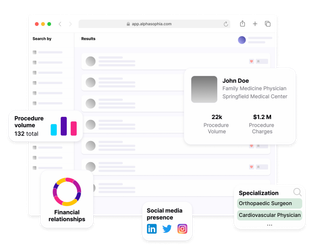Why Are Healthcare Analytics Platforms So Expensive? A Look at Claims Data Costs & Hidden Pricing Models

Healthcare databases like AcuityMD and Definitive Healthcare are powerful tools for medical device companies, pharma, and healthcare service providers. They help organizations segment the market, identify high-value healthcare providers, and launch data-driven outreach campaigns.
However, if you’ve ever had a pricing conversation with them, you’ve probably been hit with sticker shock. The price tag can be high — and often frustratingly unclear.
Let’s unpack why.
1. 💰 Claims Data Is Costly to Acquire and Maintain
At the heart of many healthcare analytics platforms is medical claims data — including CPT, ICD-10, and HCPCS codes billed to public and private insurers. This data is typically sourced from clearinghouses and commercial aggregators, such as Symphony Health or IQVIA, which charge significant licensing fees.
Ingesting, standardizing, and updating this data regularly is resource-intensive, often involving:
-
Advanced ETL pipelines
-
Data science teams for validation
-
Large cloud infrastructure costs
This backend complexity contributes to the high cost of tools built on this data.
2. 🕵️ Intransparent Pricing Models Inflate Your Quote
One of the most common frustrations we hear from buyers is the lack of transparent pricing in the healthcare SaaS space.
Companies like AcuityMD or Definitive Healthcare will often quote you based on:
-
Your company size
-
Your funding stage
-
The perceived urgency of your need
Not on the actual value or scope of the product you’re buying.
This opaque approach makes it hard to compare platforms, evaluate ROI, or predict future costs as your data needs grow.
✅ Pro Tip: Prioritize platforms with clear pricing tiers, like Alpha Sophia or CarePrecise, where you can understand your investment upfront.
3. 🪤 Multi-Year Contracts Hide Long-Term Costs
Sometimes, you’ll be offered a “discounted” first-year price — but only if you sign a multi-year agreement. The catch? You may need to purchase add-ons (like contact information, procedural data, or competitive analytics) later to get full value from the tool.
These upgrades are rarely included in the initial quote and can lead to:
-
Fragmented workflows
-
Budget overages
-
Team dissatisfaction
Always ask:
-
What’s not included?
-
How often is data refreshed?
-
What happens if we need to pivot our use case?
How to Choose the Right Healthcare Analytics Platform
Here’s what to look for when selecting a platform for healthcare provider targeting, market sizing, or outreach campaigns:
✅ Transparent pricing (no hidden fees, no multi-year traps)
✅ Full access to all data types: claims, contacts, organizations, trends
✅ Regular data updates (at least annually, ideally quarterly)
✅ Export capabilities into your CRM (e.g., Salesforce, HubSpot)
✅ Support for CPT/ICD analysis, physician profiling, and KOL identification
You can explore tools like:
-
Alpha Sophia – Built for MedTech commercial teams; transparent pricing and all-payer claims data
-
CarePrecise Access – Raw NPI and healthcare org datasets for power users
-
Open Payments Data – Free tool to analyze physician-industry relationships
Final Thought: Don’t Overpay for Healthcare Data
You deserve clarity, flexibility, and value when investing in healthcare analytics. By asking the right questions and choosing transparent vendors, you can unlock insights without locking yourself into costly, bloated contracts.
🔍 Looking for affordable healthcare claims data or a clear path to your top physician targets?
Start by evaluating platforms that focus on data accessibility, not just sales volume.
Affordable healthcare data by Alpha Sophia

